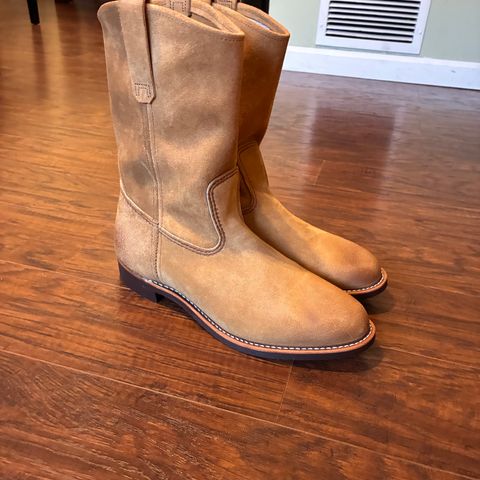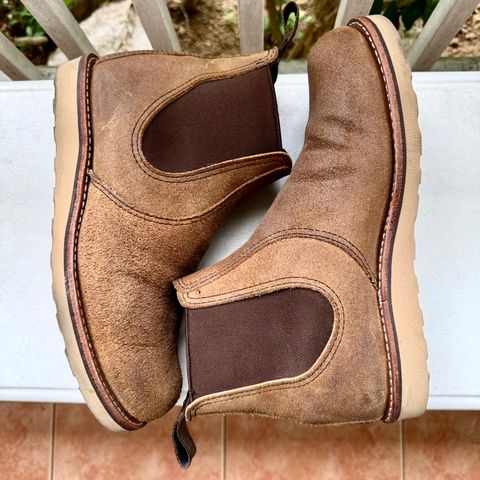About
Hawthorne is a distinctive color variation of Muleskinner leather, a proprietary roughout leather produced by S.B. Foot Tanning Company in Red Wing, Minnesota. Distinguished by its burnished appearance with visual texture, Hawthorne presents a toasted brown tone that combines the durability and toughness of full-grain roughout construction with specialized finishing techniques. The oil finish gives Hawthorne a darker color compared to untreated similar leathers, creating a rich, warm appearance that ages beautifully over time.[1][2]
About
Hawthorne is a distinctive color variation of Muleskinner leather, a proprietary roughout leather produced by S.B. Foot Tanning Company in Red Wing, Minnesota. Distinguished by its burnished appearance with visual texture, Hawthorne presents a toasted brown tone that combines the durability and toughness of full-grain roughout construction with specialized finishing techniques. The oil finish gives Hawthorne a darker color compared to untreated similar leathers, creating a rich, warm appearance that ages beautifully over time.[1][2]
Hawthorne Muleskinner features the characteristic roughout orientation where the full-grain hide's rough side faces outward, maintaining complete structural integrity without splitting or thinning. The burnished texture appears prominently in high-wear areas like the toe and heel, where the leather's surface develops compressed, polished patches that contrast with preserved texture in protected regions. This differential aging creates evolving visual character that reflects individual use patterns while maintaining the trademark toughness and appeal of the Muleskinner leather family.[2][3]
Characteristics
Color and Appearance
Hawthorne presents a medium to dark brown tone with warm, toasted undertones when new. The burnished finishing process creates intentional color variation across each hide, producing visual depth that distinguishes Hawthorne from uniform smooth leathers. The oil treatment enhances color richness while providing the darker presentation characteristic of this variation.[1][5]
The burnished look appears as deliberate texture variations where mechanical finishing has compressed and polished the rough surface selectively. These burnished areas show deeper color and subtle sheen compared to un-burnished regions, creating visual interest across the leather's surface. The burnishing pattern varies by hide, with each piece displaying unique characteristics determined by the tannery's specialized artistic process.[2]
As full-grain roughout leather, Hawthorne exhibits longer, more irregular nap than conventional suede. The exposed corium layer presents natural fiber texture that creates depth and tactile variation. Unlike suede's uniform, short pile achieved through buffing split leather, Hawthorne's surface originates from the hide's natural structure, producing authentic roughout character.
Texture and Surface Characteristics
The leather features visual texture that combines rough nap with burnished areas. High-contact zones during manufacturing receive intentional burnishing that compresses fibers and creates smooth patches within the overall textured surface. This combination of rough and burnished areas produces the signature Muleskinner appearance that emphasizes material character.[2][3]
The textured nap resists showing scuffs and marks that would appear prominently on smooth leather surfaces. Minor abrasions blend into the existing texture rather than creating distinct blemishes. This wear-resistant quality makes Hawthorne Muleskinner suitable for boots experiencing regular use where maintaining pristine appearance is impractical.
Structural Properties
Hawthorne maintains full-grain construction characteristics despite its roughout orientation. The complete hide thickness without splitting provides tensile strength and tear resistance equivalent to grain-side leather. This structural integrity distinguishes Muleskinner from split suede, which loses material and strength during production splitting operations.[1]
The leather's roughout construction combined with oil treatment provides durability for demanding applications. The full-grain foundation retains natural strength while the textured surface conceals wear that would show prominently on smooth-finished leathers.
Manufacturing Process
Tanning and Retanning
Hawthorne Muleskinner production begins with steerhides sourced within 600 miles of Red Wing, Minnesota. Following initial chrome tanning to create wet blues at Twin City Tanning, hides arrive at S.B. Foot for specialized roughout treatment. The tannery applies a special soft retan formula designed to maintain soft hand feel while preserving durability.[1]
The retanning step modifies the leather's fiber structure to achieve optimal balance between suppleness and toughness. This specialized formula contributes to Muleskinner's characteristic properties, differentiating it from standard roughout leathers produced through conventional chrome tanning alone.
Oil Treatment and Finishing
Following retanning, specialty oils are impregnated into the leather during drum processing. This fat liquoring stage enhances durability, water resistance, and long-term performance. The oiling process takes 14 to 20 hours in traditional wooden drums, allowing thorough oil penetration throughout the leather's fiber structure.[1]
The oil treatment provides Hawthorne its darker toasted color compared to untreated alternatives. The oils enhance color richness while contributing to the leather's utility and durability characteristics. Hawthorne's specific oil formulation creates its distinctive appearance within the Muleskinner family.
Burnishing and Quality Control
The finishing stage includes burnishing operations that create Hawthorne's characteristic visual texture. Mechanical finishing compresses and polishes the rough surface selectively, producing variations in texture and color depth. Each hide develops unique visual characteristics through this process, which S.B. Foot describes as requiring artistic skill to achieve the distinctive color.[2]
Quality control includes thickness gauge evaluation and grading from A to E based on imperfections. A-grade leather is designated for Red Wing Heritage line products. Each hide undergoes careful testing and sampling prior to finishing, ensuring consistent quality across production.[2]
Aging and Patina Development
Hawthorne Muleskinner's appearance evolves with use, revealing increasingly varied texture as the rough surface wears unevenly. High-contact areas develop burnished patches where the nap compresses through repeated flexing and friction. Protected regions maintain their original texture, creating contrast that emphasizes the boot's use patterns.[3]
The leather ages beautifully over time, with the toasted brown tones deepening in high-wear areas while lighter tones persist in protected zones. This differential aging creates visual depth that reflects individual wearing habits and care approaches. The burnished areas expand gradually, with the toe box, vamp creases, and heel counter showing the most prominent character development.
Unlike smooth-finished leathers that display creases and color variations dramatically, Hawthorne's roughout construction shows gradual texture evolution without sudden visual changes. This consistent aging process appeals to users seeking boots that develop character steadily while maintaining recognizable appearance throughout their life.
Care and Maintenance
Cleaning
Hawthorne Muleskinner requires minimal routine maintenance compared to smooth-finished leathers. Regular cleaning involves stiff bristle brushing to remove accumulated dirt and debris from the nap. The brushing action lifts leather fibers, dislodging particulates while redistributing the nap for uniform appearance.[5][6]
For stubborn stains or heavily soiled areas, use the Eraser Bar from a Roughout/Nubuck Cleaner Kit directly on affected regions. If stains persist, wet the Eraser Bar slightly and repeat the cleaning process. Allow the leather to dry completely before using a bristle brush to restore the nap.[5][6]
The textured surface naturally conceals minor soiling that would necessitate immediate attention on grain-side leather. Manufacturers recommend maintenance intervals of one to two times per year under typical conditions, with frequency increasing only in harsh weather or intensive use scenarios.
Conditioning
Mink Oil is recommended for conditioning Hawthorne Muleskinner, though it should be applied sparingly. The oil maintains leather suppleness and replaces oils lost through wear and environmental exposure. Users should note that Mink Oil darkens leather significantly, intensifying Hawthorne's already rich brown tones. Apply using cloth or fingers, working the conditioner into the leather surface lightly.[3][5]
Alternatively, apply a light, even coat of Leather Cream using fingers, cloth, or sponge for conditioning without the dramatic darkening effect of Mink Oil. The leather's full-grain construction and factory oiling allow extended periods between conditioning compared to split leathers.[6]
Protection
Lightly mist Hawthorne Muleskinner with Leather Protector from six to eight inches away to provide invisible protection against moisture, dirt, oil, and mud. This protective treatment does not alter appearance as dramatically as Mink Oil while guarding against environmental exposure. Reapply periodically to maintain effectiveness, particularly before extended wear in challenging conditions.[5][6]
Applications
Red Wing Iron Ranger 8083
The Iron Ranger 8083 represents Hawthorne Muleskinner's most prominent application. This 6-inch heritage boot features Vibram 430 Mini-lug outsole, Goodyear leather welt construction, and Last No. 8 with bump toe design. Originally designed for iron miners in the 1930s working Minnesota's Mesabi Iron Range, the Iron Ranger combines work boot-inspired design with roughout leather's durability.[1][3]
The boot includes nickel eyelets and steel speed hooks, double leather toecap for extra strength, and steel shank for support. Black taslan laces complement the Hawthorne leather's warm brown tones. The leather's burnished appearance and textured surface align with the Iron Ranger's rugged aesthetic while providing practical performance for regular wear. Retail pricing stands at $349.99 USD or €399.95 EUR.[1][3]
Red Wing Blacksmith 3344
The Blacksmith 3344 utilizes Hawthorne Muleskinner in a plain-toe 6-inch boot design dating back to classic American work shoes of the 1900s. The boot features Vibram 430 Mini lug sole in brown, brown waxed flat laces, and D (Medium) width. The burnished leather provides vintage appeal while the absence of cap toe design emphasizes the leather's textured appearance as primary visual element.[4]
European retail pricing for the Blacksmith 3344 stands at €379.95. Care recommendations include Mink Oil and Nubuck/Suede Cleaner kit to maintain the leather's character through regular use.[4]
Red Wing Pecos 8060
The Pecos 8060 incorporates Hawthorne Muleskinner in an 11-inch pull-on boot design without lacing hardware. This roper-style cowboy boot, originally introduced in 1958, features Goodyear welt construction, steel shank, Last No. 17 dating to the 1930s with narrow, elegant shape, and brown Chemigum outsole. The premium leather comfort pad provides cushioning for extended wear.[5]
The leather's low-maintenance characteristics align with the Pecos design's emphasis on convenience and durability. The pull-on construction combined with Muleskinner's toughness creates practical footwear for ranch work and outdoor applications. Retail price stands at $369.99 USD.[5]
Why Choose Hawthorne Muleskinner?
Hawthorne Muleskinner combines full-grain durability with distinctive burnished appearance and low-maintenance characteristics. The toasted brown color provides versatile aesthetic suitable for both heritage and work boot applications, while the roughout construction conceals wear and requires minimal care compared to smooth-finished leathers.
The leather's oil treatment and full-grain foundation ensure long-term performance in demanding conditions. For users prioritizing boots that develop individual character while maintaining structural integrity through years of use, Hawthorne Muleskinner delivers proven quality from S.B. Foot Tanning Company's 150-year leather-making expertise.
The burnished texture and aging properties create boots that serve as visible records of use while maintaining recognizable appearance. Each pair develops unique patina reflecting individual wear patterns, providing genuine distinction in an era of mass production.
References
"Iron Ranger 08083". Red Wing Shoes. Retrieved October 14, 2025.
"Leathers". S.B. Foot Tanning Company. Retrieved October 14, 2025.
"8083 Iron Ranger Hawthorne Muleskinner". Red Wing Amsterdam. Retrieved October 14, 2025.
"3344 Blacksmith Hawthorne Muleskinner". Red Wing Amsterdam. Retrieved October 14, 2025.
"Pecos 08060". Red Wing Shoes. Retrieved October 14, 2025.
"How-to Care: Nubuck / Roughout Leather". Red Wing Shoes. Retrieved October 14, 2025.




































































